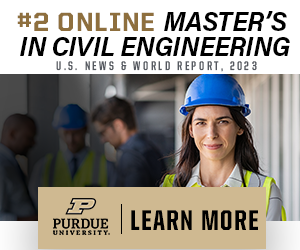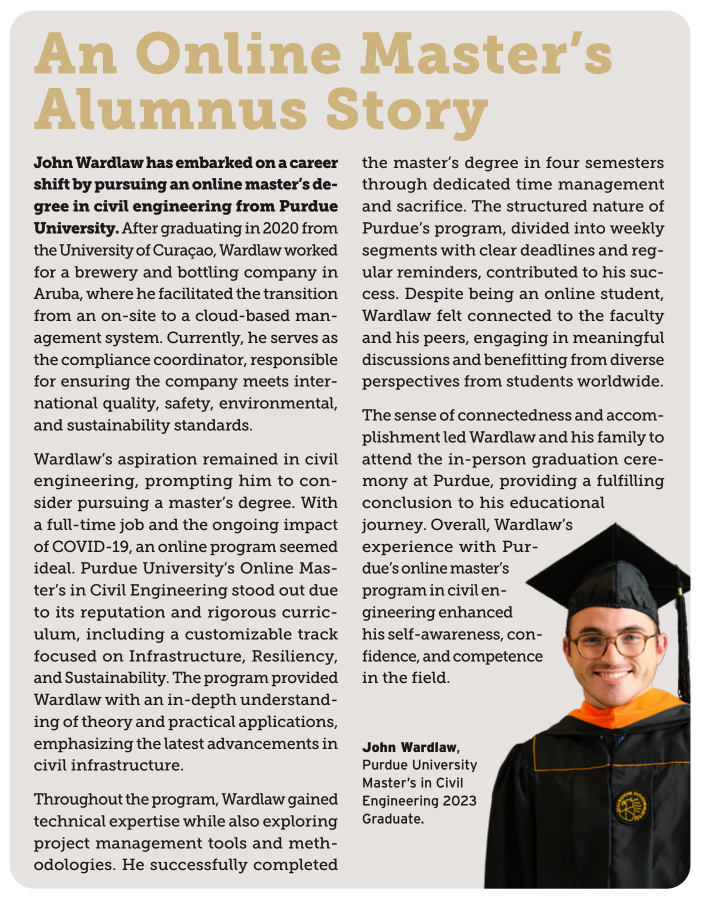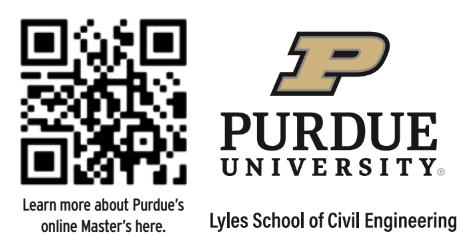
7 minute read
ADVANCING INTERDISCIPLINARY ENGINEERING SOLUTIONS FOR CRITICAL INFRASTRUCTURE CHALLENGES
By Rachel Barton, M.A. - Technical Content Writer at Purdue University
The demand for civil engineers with interdisciplinary education and current skillsets is on the rise as the United States invests in critical infrastructure projects funded by a $260 billion federal infrastructure bill. To meet this demand, working professional engineers are seeking out education opportunities that offer interdisciplinary engineering skills, so they can provide greater value to projects, potential employers, and stakeholders. In-demand interdisciplinary engineering skills include the entire spectrum of building and maintaining public resources, water quality and scarcity, and transportation systems, while developing strategies using Artificial Intelligence (AI) to achieve sustainable solutions.
Top-ranked universities, such as Purdue University, offer online interdisciplinary engineering programs designed to help engineers excel in dynamic careers. Specifically, Purdue’s Lyles School of Civil Engineering provides three in-demand tracks that are designed to give civil engineers interdisciplinary education in relevant, high-impact disciplines. By choosing from sustainable water; infrastructure, resiliency, and sustainability; and smart mobility tracks, civil engineers can focus their education on critical issues that will define the future of the field.
Developing Sustainable Solutions to the Water Crisis
Water crises continue to be pressing global issues that jeopardize human health, food security, and environmental sustainability. Engineers worldwide are actively working towards sustainable solutions to address this urgent challenge. Through collaborative research, educational initiatives, and partnerships, engineers are making significant progress in water treatment, conservation, and management.
Engineers from various disciplines are joining forces to tackle water crises holistically. Researchers are developing innovative technologies to combat water scarcity and improve water quality advancements such as nanomaterial-based water purification methods, which show promise in efficiently removing contaminants and toxins, offering cost-effective and scalable solutions.
Education plays a vital role in addressing water crises. Universities and educational institutions are equipping students with the knowledge and skills to address complex water-related challenges. Hands-on experiences, collaborative projects, and practical problem-solving activities enable students to develop a deep understanding of water management practices and foster a culture of innovation and sustainability.

Collaboration between engineers, industry partners, government agencies, and non-profit organizations is key to creating a meaningful impact. These partnerships facilitate the translation of research findings into practical solutions and promote the adoption of sustainable water management practices. By working closely with stakeholders, engineers ensure that their innovations address real-world needs and contribute to long-term sustainability.
Addressing Transportation Shortages with Smart Mobility
Smart mobility is experiencing three significant trends that are shaping the future of transportation. These trends include the rise of autonomous vehicles, the integration of AI and data analytics, and the development of connected infrastructure.
1. Autonomous vehicles are revolutionizing transportation by using a combination of sensors, cameras, and advanced algorithms to navigate roads and make decisions. The benefits of autonomous vehicles are vast, including increased safety, reduced traffic congestion, and improved fuel efficiency.
2. The integration of AI and data analytics is another key trend in smart mobility. AI algorithms can process vast amounts of data collected from various sources, such as vehicles, infrastructure, and weather sensors, to optimize traffic flow, predict demand, and improve transportation efficiency. This integration enables intelligent decision-making, leading to better route planning, real-time traffic management, and enhanced user experiences.
3. Connected infrastructure is a critical aspect of smart mobility, enabling seamless communication between vehicles, infrastructure, and users. This infrastructure includes dedicated short-range communication (DSRC) and 5G networks, as well as intelligent transportation systems (ITS) that gather and share data in realtime. By connecting vehicles to the surrounding environment, infrastructure can provide valuable information to drivers, such as traffic conditions, parking availability, and road hazards.

These three trends are interconnected and work together to create a comprehensive smart mobility ecosystem. Autonomous vehicles rely on AI and data analytics to make informed decisions, while connected infrastructure provides the necessary communication channels and real-time data exchange. By embracing these trends, smart mobility has the potential to transform transportation systems, making them safer, more efficient, and environmentally friendly.
Engineering Resilient Infrastructure
Much of America’s critical transportation infrastructure, including bridges, roads, and ports, needs to be updated and modernized. The new federal infrastructure bill promises to invest billions into creating and maintaining sustainable infrastructure that will last for generations, but the engineers who are spearheading these infrastructure improvements face unique challenges that require a broad range of skills. By utilizing interdisciplinary knowledge, emerging technologies, and smart engineering, civil engineers have the power to transform the country’s infrastructure and build a stronger future.

One of the key challenges to infrastructure improvement is population growth and urbanization. It is estimated that the world’s population will reach 9.8 billion by 2050. Additionally, the world’s urban population will grow 35% by 2050. This population growth is predicted to add significant strain to urban infrastructure, much of which already needs to be updated. As engineers work to design roads and bridges that fit the needs of burgeoning city populations, they are also tasked with creating infrastructure that is resilient to future growth, as well as environmental factors like climate change. Since many cities are located on coasts around the world, urban populations are particularly vulnerable to climate disasters like flooding and hurricanes. To mitigate the effects of climate change, many cities are focusing on developing more sustainable infrastructure that works with, rather than against, the existing ecosystem.
Emerging technologies and interdisciplinary partnerships can help engineers develop infrastructure that can accommodate population growth and maintains climate health. Engineering teams can work together to design infrastructure projects in tandem with smart mobility solutions and water management practices to improve cities holistically. Additionally, technologies like AI and data analytics have important applications across all areas of civil engineering. The quest for more sustainable infrastructure is inextricably connected to developing greener transportation solutions and confronting the water crises.
The Intersection of Tracks and the Growing Need for Civil Engineers
The intersection of the three tracks— Sustainable Water, Smart Mobility, and Infrastructure, Resiliency, and Sustainability—reflects the multidimensional challenges faced by civil engineers in the modern era. As infrastructure projects increasingly demand interdisciplinary approaches, civil engineers must possess diverse skillsets and be able to work collaboratively across domains. The online master’s in civil engineering program at Purdue University recognizes this need and offers a curriculum that combines technical knowledge with a holistic understanding of sustainable and resilient solutions.

In a world marked by change and uncertainty, civil engineers can use their interdisciplinary knowledge to advance solutions to some of the planet’s most pressing problems. Water scarcity, urbanization, and climate change are global issues that require innovative engineering solutions. By specializing in one of the three tracks, civil engineers can address specific challenges and become leaders in their respective fields. The online nature of the program allows professionals to enhance their skillsets while maintaining their careers, making it accessible to a wider range of aspiring engineers seeking to make a meaningful impact.
Purdue University’s online master’s in civil engineering offers a comprehensive and flexible educational experience, enabling civil engineers to tackle critical infrastructure challenges effectively. Purdue equips engineers with the knowledge and tools to develop innovative and sustainable solutions to complex infrastructure problems. As the nation and the world continue to invest in critical infrastructure projects, the demand for civil engineers with interdisciplinary expertise in these areas will only continue to grow. Purdue University’s online program positions graduates at the forefront of the engineering field, ready to shape the future of sustainable infrastructure and make a lasting impact on society.
Learn more about Purdue’s online Master’s here.

The appearance of or reference to the U.S. Army Corps of Engineers, the U.S. Army, the U.S. Department of Defense, or the U.S. Government does not imply or indicate endorsement by any of these entities.










